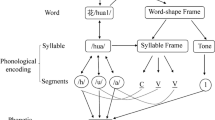Abstract
The present study tracked the time course of the syllable frequency effect in French visual word recognition, by varying the strength of spreading activation between letters and phonological syllables. The frequency of phonological first syllables and the frequency of orthographic first syllables were conjointly manipulated in two lexical decision tasks. In Experiment 1, word parsing into syllable units was supported by orthographic redundancy. No interaction between orthographic and phonological syllable frequency was found. In Experiment 2, word parsing into syllables was not marked by orthographic redundancy. Results showed an interaction between orthographic and phonological syllable frequency: the syllable frequency effect was inhibitory when orthographic syllable frequency was high, whereas it was facilitatory when orthographic syllable frequency was low. Decreasing the strength of syllable activation (i.e., with orthographic syllables of low frequency and ambiguous syllable boundaries) prevented the activation of lexical competitors before target word recognition, leading to a facilitatory effect of syllable frequency. The present study provides evidence that the net effect of syllable frequency is strongly related to its time course, and that the strength of syllable activation, which depends on orthographic properties, determines the direction of the net effect.

Similar content being viewed by others
References
Baayen, R. H., Davidson, D. J., & Bates, D. M. (2008). Mixed-effects modeling with crossed random effects for subjects and items. Journal of Memory and Language, 59, 390–412.
Barber, H., Vergara, M., & Carreiras, M. (2004). Syllable frequency effects in visual word recognition: Evidence from ERPs. Cognitive Neuroscience and Neuropsychology, 15, 545–548.
Carreiras, M., Alvarez, C., & De Vega, M. (1993). Syllable frequency and visual word recognition in Spanish. Journal of Memory and Language, 32, 766–780.
Carreiras, M., & Perea, M. (2004). Naming pseudowords in Spanish: Effects of syllable frequency. Brain and Language, 90, 393–400.
Chetail, F., & Mathey, S. (2009a). The syllable frequency effect in visual recognition of French words: A study in skilled and beginning readers. Reading and Writing: An Interdisciplinary Journal, 22, 955–973.
Chetail, F., & Mathey, S. (2009b). InfoSyll: A syllabary providing statistical information on phonological and orthographic syllables. Journal of Psycholinguistic Research, 39, 485–504.
Cholin, J., Dell, G. S., & Levelt, W. J. M. (2011). Planning and articulation in incremental word production: Syllable-frequency effects in English. Journal of Experimental Psychology. Learning, Memory, and Cognition, 37(1), 109–122.
Cholin, J., Levelt, W. J. M., & Schiller, N. O. (2006). Effects of syllable frequency in speech production. Cognition, 99, 205–235.
Colé, P., Magnan, A., & Grainger, J. (1999). Syllable-sized units in visual word recognition: Evidence from skilled and beginning readers of French. Applied Psycholinguistics, 20, 507–532.
Conrad, M., Carreiras, M., Tamm, S., & Jacobs, A. (2009). Syllables and bigrams: Orthographic redundancy and syllabic units affect visual word recognition at different processing levels. Journal of Experimental Psychology: Human Perception and Performance, 35(2), 461–479.
Conrad, M., Grainger, J., & Jacobs, A. (2007). Phonology as the source of syllable frequency effects in visual word recognition: Evidence from French. Memory and Cognition, 35, 974–983.
Conrad, M., & Jacobs, A. (2004). Replicating syllable frequency effects in Spanish in German: One more challenge to computational models of visual word recognition. Language and Cognitive Processes, 19, 369–390.
Conrad, M., Tamm, S., Carreiras, M., & Jacobs, A. (2010). Simulating syllable frequency effects within an interactive activation framework. European Journal of Cognitive Psychology, 22, 861–893.
Content, A., Mousty, P., & Radeau, M. (1990). Brulex: Une base de données lexicales informatisée pour le français écrit et parlé [Brulex: A computerized lexical database for written and spoken French]. L’Année Psychologique, 90, 551–566.
Cutler, A., McQueen, J. M., Norris, D., & Somejuan, A. (2001). The roll of the silly ball. In E. Dupoux (Ed.), Language, brain and cognitive development: Essays in honor of Jacques Mehler (pp. 181–194). Cambridge, MA: MIT Press.
Doignon, N., & Zagar, D. (2005). Illusory conjunctions in French: The nature of sublexical units in visual word recognition. Language and Cognitive Processes, 20, 443–464.
Doignon-Camus, N., & Zagar, D. (2007). Does the activation of syllables depend on their frequency: A study with illusory conjunction paradigm. In Talk presented at the XVth meeting of the European society for cognitive psychology. Marseille, France.
Doignon-Camus, N., Zagar, D., & Mathey, S. (2009). Can we see syllables in monosyllabic words? A study with illusory conjunctions. Journal of Cognitive Psychology, 21(4), 599–614.
Dominguez, A., Cuetos, F., & De Vega, M. (1993). Efectos diferenciales de la frecuencia silábica: dependencia del tipo de prueba y características de los estímulos. Estudios de Psicología, 50, 5–31.
Ferrand, L., Segui, J., & Grainger, J. (1996). Masked priming of word and picture naming: The role of syllable units. Journal of Memory and Language, 35, 708–723.
Forster, K. I. F., & Chambers, S. M. (1973). Lexical access and naming time. Journal of Verbal Learning & Verbal Behaviour, 12, 627–635.
Hutzler, F., Bergmann, J., Conrad, M., Kronbichler, M., Stenneken, P., & Jacobs, A. (2004). Inhibitory effects of first syllable frequency in lexical decision: An event related potential study. Neuroscience Letters, 372, 179–184.
Hutzler, F., Conrad, M., & Jacobs, A. M. (2005). Effects of syllable-frequency in lexical decision and naming: An eye-movement study. Brain and Language, 92(2), 138–152.
Kinoshita, S., Mozer, M. C., & Forster, K. I. (2011). Dynamic adaptation to history of trial difficulty explains the effect of congruency proportion on masked priming. Journal of Experimental Psychology: General, 140(4), 622–636.
Laganaro, M., & Alario, F. X. (2006). On the locus of syllable frequency effect. Journal of Memory and Language, 55, 178–196.
Levelt, W. J. M., Roelofs, A., & Meyer, A. S. (1999). A theory of lexical access in speech production. Behavioral and Brain Sciences, 22, 59–60.
Levelt, W. J. M., & Wheeldon, L. R. (1994). Do speakers have access to a mental syllabary? Cognition, 50, 239–269.
Luce, P. A., & Pisoni, D. B. (1998). Recognizing spoken words: The neighborhood activation model. Ear and Hearing, 19, 1–36.
Macizo, P., & van Petten, C. (2007). Syllable frequency in lexical decision and naming of English words. Reading and Writing: An Interdisciplinary Journal, 20, 295–331.
Mathey, S., & Zagar, D. (2002). Lexical similarity in visual word recognition: The effect of syllabic neighbourhood in French. Current Psychology Letters, 8, 107–121.
Mathey, S., Zagar, D., Doignon, N., & Seigneuric, A. (2006). The nature of the syllabic neighbourhood effect in French. Acta Psychologica, 123, 372–393.
McClelland, J., & Rumelhart, D. (1981). An interactive model of context effects in letter perception: Part 1. An account of basic findings. Psychological Review, 88, 376–406.
McQueen, J. M., & Cutler, A. (1998). Spotting (different types of) words in (different types of) context. In Proceedings of the fifth international conference on spoken language processing, (Vol. 6, pp. 2791–2794). Sydney: Australian Speech Science and Technology Association.
Mehler, J., Dommergues, J.-Y., Frauenfelder, U. H., & Segui, J. (1981). The syllable’s role in speech segmentation. Journal of Verbal Learning and Verbal Behavior, 20, 298–305.
Perea, M., & Carreiras, M. (1998). Effects of syllable frequency and syllable neighbourhood frequency in visual word recognition. Journal of Experimental Psychology, 24, 134–143.
Prinzmetal, W., Treiman, R., & Rho, S. H. (1986). How to see a reading unit? Journal of Memory and Language, 25, 461–475.
Rapp, B. (1992). The nature of sublexical orthographic organization: The bigram trough hypothesis examined. Journal of Memory and Language, 31, 33–53.
Seidenberg, M. (1987). Sublexical structures in visual word recognition: Access units or orthographic redundancy? In M. Coltheart (Ed.), Attention and performance XII: The psychology of reading (pp. 245–263). Hove: Lawrence Erlbaum Associates Ltd.
Stenneken, P., Conrad, M., & Jacobs, A. (2007). Processing of syllables in production and recognition tasks. Journal of Psycholinguistic Research, 36(1), 65–78.
Whaley, C. (1978). Word-nonword classification time. Journal of Verbal Learning & Verbal Behaviour, 17, 143–154.
Yates, M. (2005). Phonological neighbors speed visual word processing: Evidence from multiple tasks. Journal of Experimental Psychology: Learning, Memory, and Cognition, 31, 1385–1397.
Yates, M. (2009). Phonological neighborhood spread facilitates lexical decisions. Quarterly Journal of Experimental Psychology, 62, 1304–1314.
Ziegler, J. C., Muneaux, M., & Grainger, J. (2003). Neighborhood effects in auditory word recognition: Phonological competition and orthographic facilitation. Journal of Memory and Language, 48, 779–793.
Author information
Authors and Affiliations
Corresponding author
Rights and permissions
About this article
Cite this article
Mahé, G., Bonnefond, A. & Doignon-Camus, N. The time course of the syllable frequency effect in visual word recognition: evidence for both facilitatory and inhibitory effects in French. Read Writ 27, 171–187 (2014). https://doi.org/10.1007/s11145-013-9438-3
Published:
Issue Date:
DOI: https://doi.org/10.1007/s11145-013-9438-3




